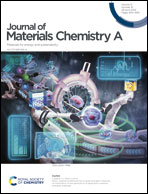Synergism of heterovalent valence state and oxygen vacancy defect engineering in Co/S co-doped TiO2 for nitrogen photoreduction to ammonia†
Abstract
Herein, we demonstrate a Co/S doped TiO2 bimetal sulfur oxide nanoparticle catalyst (labeled CoTiOS) with heterovalent Co states and abundant oxygen vacancy (Ov) defects for the photocatalytic nitrogen reduction reaction (PNRR) in an ambient environment. Co/S co-doping converted TiO2 into a catalyst for visible light photocatalytic nitrogen fixation. The incorporation of Co endows TiO2 with better electrical conductivity and electron trapping ability. The introduction of sulfur adjusts the amount of Ov and Co3+/Co2+ ratio. Ov acts as an active site for trapping H2O and activating H2O to generate a proton for the N2 reduction reaction. Active atoms Co3+ were exposed and activated for N2, and electrons hopping between Co2+ and Co3+ enhanced electron transfer. CoTiOS-3 with appropriate Co/S doping has abundant Ov, suitable heterovalent Co3+/Co2+ ratios, higher surface active sites, smaller crystal sizes, higher specific surface area (SBET), and fast transfer of electrons, and it exhibited a super PNRR activity of 491.56 μmol g−1 h−1, an apparent quantum efficiency (AQE) of 1.89% at 420 nm and a solar-to-ammonia (STA) conversion efficiency of 0.083% in pure water under AM1.5G light irradiation. It also exhibited excellent stability and persistence and shows potential for photocatalytic nitrogen fixation.



 Please wait while we load your content...
Please wait while we load your content...